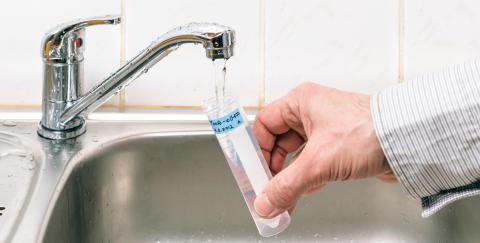Strontium
What is strontium?
Strontium is a mineral that has radioactive and non-radioactive forms. Radioactive strontium is formed during nuclear reactions and is not likely to be found in high levels in Wisconsin.
Non-radioactive strontium is used make ceramics, glass products, paints, fluorescent lights, and some medicines. It is formed naturally in the environment and is commonly found in Wisconsin. The rest of this page will focus on non-radioactive strontium.
How can I be exposed to strontium?
People can be exposed to non-radioactive strontium from air, soil, food, and water. Air and soil naturally contain small levels of non-radioactive strontium. Foods like fish, vegetables, and livestock naturally contain low levels of non-radioactive strontium.
Strontium is naturally present in surface water and groundwater. Certain parts of Wisconsin have higher levels of strontium in their groundwater than others due the types of rocks found that are present where the groundwater is coming from.
How can strontium affect my health?
Exposure to high levels of non-radioactive strontium in drinking water can affect how bones develop. Strontium can substitute for calcium in growing bones and reduce vitamin D and calcium uptake in the body. Some people are more sensitive to the effects of strontium, including infants, children, and teenagers and people who are pregnant, have impaired kidney function, or have a calcium deficiency.
How can I protect myself from strontium?
In certain parts of Wisconsin, private well water can be the biggest source of non-radioactive strontium exposure.
You should test your private well for strontium if you live in eastern or northern Wisconsin.
- Test twice over a two-year period in two different seasons, fall and spring being best.
- When testing, you should use a Wisconsin certified lab.
Take action if the strontium level is at or above 1,500 micrograms per liter (µg/L).
- Collect a second sample to verify test results.
If the strontium level is still high:
- Everyone should use a different source of water for drinking and preparing foods that take up a lot of water (like rice, oatmeal, and gelatin).
- Options include bottled water, water from a well without issues, and water from a public system.
- It is ok to use the water for bathing, brushing teething, and washing dishes.
Find a long-term solution.
- Options include installing a treatment device and drilling a new well.
- While there are no treatment devices certified for strontium, water softeners have been shown to effective in many cases. The Wisconsin Department of Safety and Professional Services (DSPS) can assist you in finding an appropriate device.
- The Wisconsin Department of Natural Resources (DNR) well compensation grant program provide funds to help address contamination in private wells.
Our Strontium in Private Wells fact sheet (P-02434p) has these steps in printable format.
Who regulates strontium in Wisconsin?
Because it is naturally occurring, the Wisconsin Department of Natural Resources (DNR) does not have air, drinking water, or surface water standards for strontium.
In 2018, the DNR requested that The Department of Health Services (DHS) develop recommended groundwater standards for strontium. In June 2019, DHS recommended a groundwater enforcement standard of 1,500 micrograms per liter (µg/L) for strontium. In February 2022, the Natural Resources Board (NRB) did not approve the groundwater standards rule for adoption.
While the NRB's decision stopped the rule-making process, it did not change DHS' scientific evaluation of the health impacts of strontium. DHS recommends that people take actions to reduce their exposure when the strontium level in private well water is equal to or greater than 1,500 µg/L (see the steps described above).
Related topics
Our groundwater standards page has information on how Wisconsin's groundwater standards are set, DHS' role in the process, and a summary of the current and recommended standards including strontium.
The Wisconsin Groundwater Coordinating Council's annual report summarizes the operations and activities occurring within the state to address groundwater issues including strontium.
The Agency for Toxic Substances and Disease Registry's ToxFAQs page has more information on non-radioactive and radioactive strontium exposure routes and health effects.


